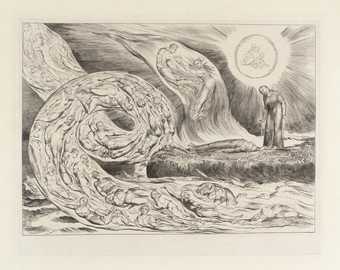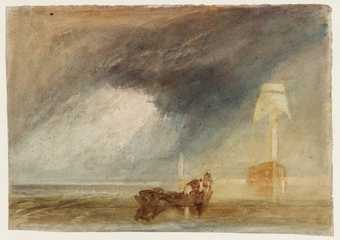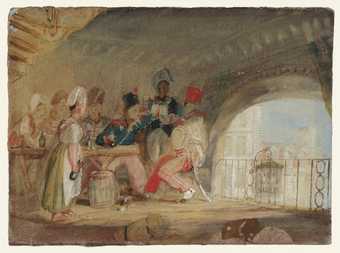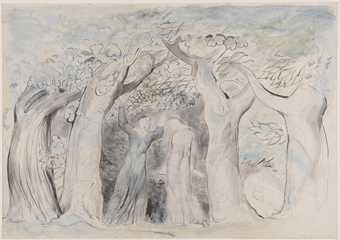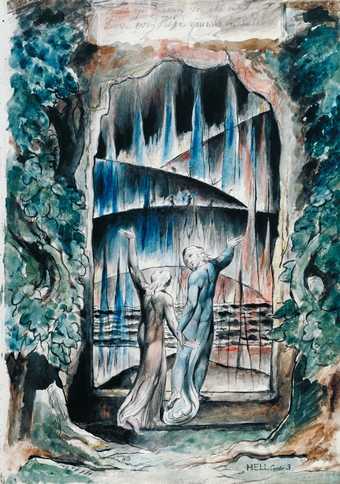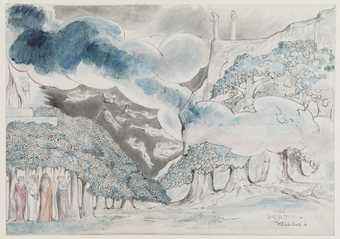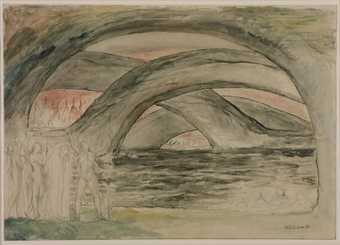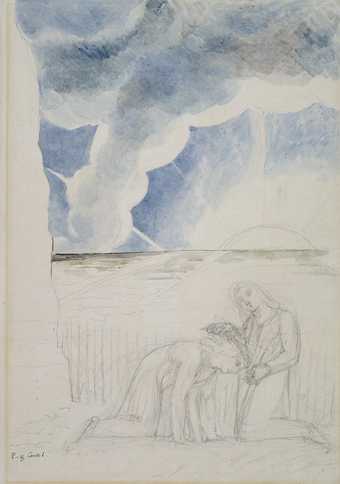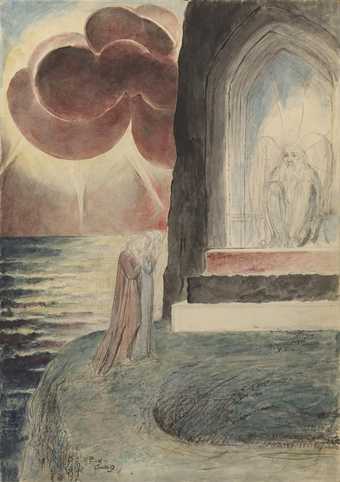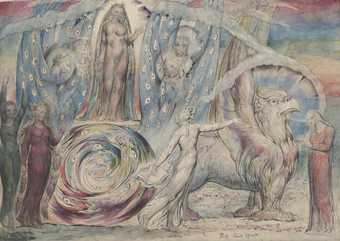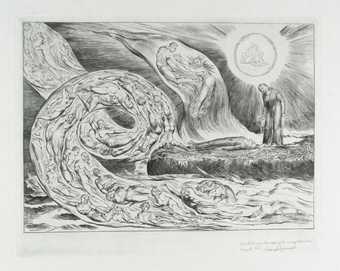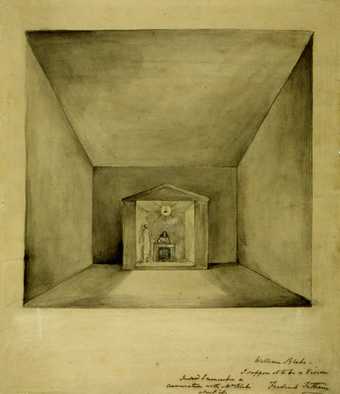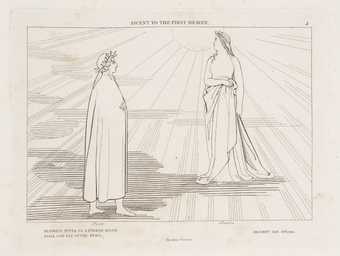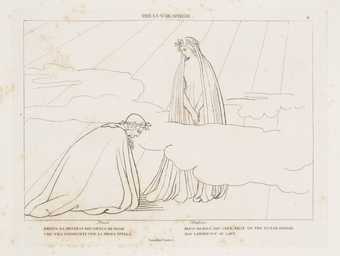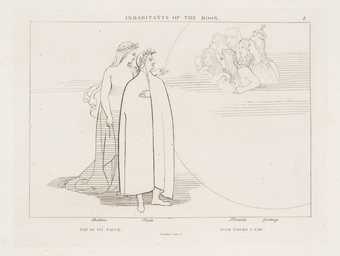
Not on display
- Artist
- William Blake 1757–1827
- Medium
- Graphite and watercolour on paper
- Dimensions
- Support: 528 × 371 mm
- Collection
- Tate
- Acquisition
- Purchased with the assistance of a special grant from the National Gallery and donations from the Art Fund, Lord Duveen and others, and presented through the Art Fund 1919
- Reference
- N03370
Display caption
Blake’s watercolour illustrations to Dante’s Divine Comedy make distinctive use of luminous yellows, blues and reds. In contrast to many watercolour painters of his day, who were concerned with creating natural-looking effects, Blake used pure colours and emphasised the drawn line. In this design, Blake shows the earthly Paradise at the top of the mountain of Purgatory.
Gallery label, February 2019
Does this text contain inaccurate information or language that you feel we should improve or change? We would like to hear from you.
Catalogue entry
N03370 Dante in the Empyrean, Drinking at the River of Light
1824–7
N 03370 / B 812 98
Pencil and watercolour 528×371 (20 3/4×14 5/8)
Inscribed ‘Par. Canto 30’ in ink over ‘Paradiso Canto 30’ in pencil b.r. and, on reverse in pencil, ‘N49 next at p16’ t.c., ‘37’ t.r. and ‘Hell Canto 26’ b.r., the last with the page turned through a right-angle
Watermarked ‘WE’
Purchased with the assistance of a special grant from the National Gallery and donations from the National Art-Collections Fund, Lord Duveen and others, and presented through the National Art-Collections Fund 1919
PROVENANCE As for N03351
EXHIBITED Tate Gallery 1947 (63); British Painting Hamburg, Oslo, Stockholm and Copenhagen 1949–50(3)
LITERATURE Rossetti 1863, p.223 no.103i, and 1880, p.234 no.125i; Roe 1953, pp.189–93 no.98, repr.; Klonsky 1980, pp.161–2, pl.101; Butlin 1981, p.587 no.812 98; Gizzi 1983, p.179 repr.
This is the only illustration in the Tate Gallery to Paradiso: XXX, 61–96. This does in fact reflect the relative paucity of illustrations to Dante's third book, ten as opposed to twenty illustrations to Purgatorio
and seventy-two to Inferno, though Blake might well have rectified this inbalance had he lived to complete the series. Dante, with Beatrice, has now left the heaven of space to enter the infinite heaven of light, love and joy, through which runs a stream of light in the form of a river. The poet kneels drinking on the left, while Beatrice is on the right.
The other figures do not appear in Dante's text. Those on the left, above Dante, symbolise the arts, represented by an aged poet (identified by Roe as the regenerate Urizen) together with a scene of painting and engraving. On the other side, according to Roe, is the realm of Nature, represented by Enion, Blake's ‘Earth-Mother’, while Beatrice is equated with Vala, the Female Will. The sparkles in the water are shown as tiny figures, ‘infant joys’. The whole scene thus represents, according to Roe's interpretation, Art and Nature raised to the Eternal World through the agency of the River of Divine Imagination; even the figures normally condemned in Blake's mythology, Urizen, Enion and Vala, are here shown in their positive aspects.
Published in:
Martin Butlin, William Blake 1757-1827, Tate Gallery Collections, V, London 1990
Explore
- leisure and pastimes(3,435)
-
- art and craft(2,383)
-
- painting(368)
- eating and drinking(409)
-
- drinking(267)
- fine arts and music(3,982)
- scroll(24)
- actions: postures and motions(9,111)
-
- kneeling(502)
- mythical, religious, fictional(260)
-
- Heaven(33)
- abstract concepts(119)
- arts and entertainment(7,210)
-
- artist, painter(2,545)
- artist, printmaker(610)
- poet(655)
You might like
-
William Blake The Circle of the Lustful: Francesca da Rimini (‘The Whirlwind of Lovers’)
1826–7, reprinted 1892 -
Joseph Mallord William Turner Sails in Golden Light
c.1824–6 -
Joseph Mallord William Turner Soldiers Drinking in a Café, ? Nantes
c.1826–8 -
William Blake Dante and Virgil Penetrating the Forest
1824–7 -
William Blake The Inscription over the Gate
1824–7 -
William Blake Homer and the Ancient Poets
1824–7 -
William Blake The Devils, with Dante and Virgil by the Side of the Pool
1824–7 -
William Blake Virgil Girding Dante’s Brow with a Rush
1824–7 -
William Blake Dante and Virgil Approaching the Angel Who Guards the Entrance of Purgatory
1824–7 -
William Blake Beatrice Addressing Dante from the Car
1824–7 -
William Blake The Circle of the Lustful: Francesca da Rimini (‘The Whirlwind of Lovers’)
1826–7, reprinted 1968 -
William Blake A Vision: The Inspiration of the Poet (Elisha in the Chamber on the Wall)
c.1819–20? -
After John Flaxman Ascent to the First Heaven
1807 -
After John Flaxman The Lunar Sphere
1807 -
After John Flaxman Inhabitants of the Moon
1807

